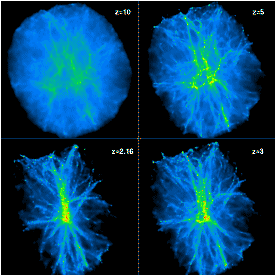This page is now very out of date, and I will be bringing it into
the 2010s (!) over the next couple of months. But for now, here's
a couple of slices of a large scale simulation with AGN feedback
that can be used to print ties. I've called these "dark matter ties"
but technically that's not true, the images actual show
the gas in galaxies and the space between galaxies (the intergalactic
medium). On large scales
this does look like the distribution of dark matter.
But, yes you can turn them into ties. Try Zazzle.com!


On
this page I've
collected a small gallery of images and movies from my research.
These images are unfortunately quite out of date now, and will be
updated. Please feel free to
download and use these images. If you use the movies (at the bottom
of the page) please give me a
credit. (For non-specialists, if the terms in captions contain terms that
are unfamiliar to
you, please
look them up in the following astrophysics glossary.)
Movies (Sorry - offline for the moment)
In 2001, in collaboration with Hugh Couchman, I
conducted a simulation that reproduced a galaxy that is a
moderate facsimilie of those that we observe. (Details in Thacker &
Couchman 2001, Astrophysical Journal, 555, L17, see also
Science, July 2001).
For comparison, visualizations of simulations of the
formation of a large (1.8 L*) galaxy without and without feedback from
supernovae are provided. The movies use a colour scheme that encodes
physical density and has a maximum at about
10 nH cm3. The final panel is approx 100 kpc
across. The matter associated with external tidal fields is not shown,
but is integrated consistently within the simulation.
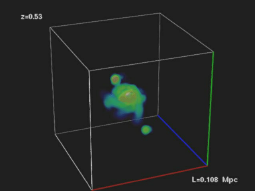
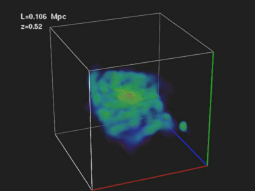
A more recent movie can be found here.
Here are some movies produced by Dave Sherfesee (formerly of
Berkeley, now somewhere in the IT business) using IDL, from a
simulation run on the Berkeley KDI compute server (this project examined
the distribution of high velocity clouds in the local group and was
conducted in collaboration with Leo Blitz).
The
simulation follows the evolution of two large halos constrained to
represent M31 and the Milky Way. Only particles in a high resolution
region centered around the two halos are shown in the movies.
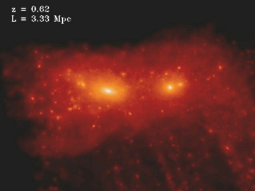
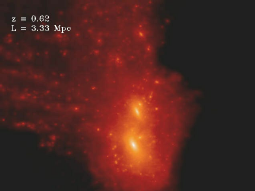
Images
The plot below is from a pilot, dark-matter only, simulation from a
project that Evan Scannapieco and I worked on while at Berkeley. The
simulation is a small Lambda CDM
5.2/h Box, with 7 million particles. A false colour density
z projection at z=1.7 is shown, with the lightest colours
corresponding to overdensities in excess of 1000.
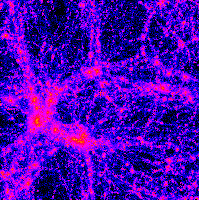
Here is a plot from the second simulation we did which includes
gas outflows and star formation. This image shows false colour log
overdensity from -3 to 3 (Warning - linked image is 2 MB), at the
comparatively early epoch of z=5.1 (a little under 10% of the current age
of the
universe).
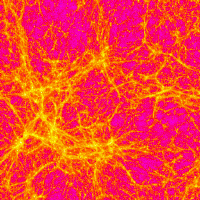
The goal of this project was to look at how the intergalactic medium
becomes polluted by metals produced in supernovae explosions.
Below are two plot of the metals. The plot on the left shows information
on the particles themselves from z=0.01 solar to 0.5 solar, while the plot
on the right shows the estimated smoothed density field (assuming rapid
mixing within the IGM).
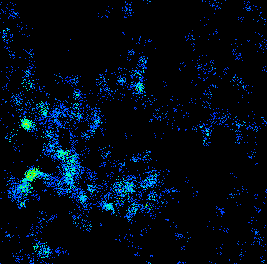
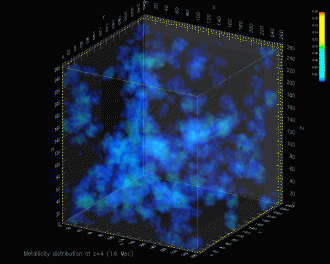
Warm dark matter vs Cold dark matter: Here are a couple of toy
simulations comparing the
structure in Lambda CDM vs Lambda WDM, with a 0.2 Mpc free streaming
length.(CDM is first, both simulations are 4 Mpc across at the
displayed epoch z=1. False colour log density.)
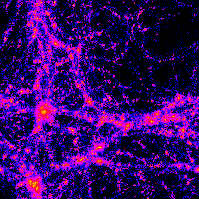
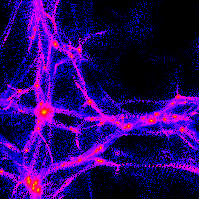
Dissipative Galaxy Formation with Feedback: Here is a pair of plots
(projections) from a
simulation of the formation of an L* disk galaxy. Gas particles
are shown colour coded in temperature from 1000 K to 108 K
(blue cold, yellow hot). The spherical region shown is 200 kpc in
diameter,
and the evolution epoch is z=1. There are 7,000 gas particles in
the galaxy (which is really quite low resolution).
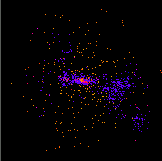
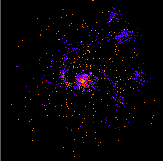
Evolution of the gas in a dark matter halo: here is a plot from my PhD
thesis showing the evolution of the gas density as the simulation evolves.
The images were created using a similar smoothing technique to that used
to create the movies.
